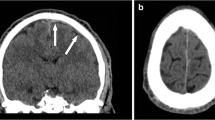Abstract
Purpose
One of the major applications of dual-energy computed tomography (DECT) is automated bone removal (BR). We hypothesized that the visualization of acute intracranial hemorrhage could be improved on BRCT by removing bone as it has the highest density tissue in the head. This preliminary study evaluated the efficacy of a DE BR algorithm for the head CT of trauma patients.
Methods
Sixteen patients with acute intracranial hemorrhage within 1 day after head trauma were enrolled in this study. All CT examinations were performed on a dual-source dual-energy CT scanner. BRCT images were generated using the Bone Removal Application. Simulated standard CT and BRCT images were visually reviewed in terms of detectability (presence or absence) of acute hemorrhagic lesions.
Results
DECT depicted 28 epidural/subdural hemorrhages, 17 contusional hemorrhages, and 7 subarachnoid hemorrhages. In detecting epidural/subdural hemorrhage, BRCT [28/28 (100%)] was significantly superior to simulated standard CT [17/28 (61%)] (p = .001). In detecting contusional hemorrhage, BRCT [17/17 (100%)] was also significantly superior to simulated standard CT [11/17 (65%)] (p = .0092).
Conclusion
BRCT was superior to simulated standard CT in detecting acute intracranial hemorrhage. BRCT could improve the detection of small intracranial hemorrhages, particularly those adjacent to bone, by removing bone that can interfere with the visualization of small acute hemorrhage. In an emergency such as head trauma, BRCT can be used as support imaging in combination with simulated standard CT and bone scale CT, although BRCT cannot replace a simulated standard CT.




Similar content being viewed by others
References
Johnson TR (2012) Dual-energy CT: general principles. AJR 199:S3–S8
McCollough CH, Leng S, Yu L, Fletcher JG (2015) Dual- and multi-energy CT: principles, technical approaches, and clinical applications. Radiology 276:637–653
Schulz B, Kuehling K, Kromen W et al (2012) Automatic bone removal technique in whole-body dual-energy CT angiography: performance and image quality. AJR 199:W646–W650
Morhard D, Fink C, Graser A, Reiser MF, Becker C, Johnson TR (2009) Cervical and cranial computed tomographic angiography with automated bone removal: dual energy computed tomography versus standard computed tomography. Investig Radiol 44:293–297
Watanabe Y, Uotani K, Nakazawa T et al (2009) Dual-energy direct bone removal CT angiography for evaluation of intracranial aneurysm or stenosis: comparison with conventional digital subtraction angiography. Eur Radiol 19:1019–1024
Zhang LJ, Wu SY, Poon CS et al (2010) Automatic bone removal dual energy CT angiography for the evaluation of intracranial aneurysms. J Comput Assist Tomogr 34:816–824
Postma AA, Hofman PA, Stadler AA et al (2012) Dual-energy CT of the brain and intracranial vessels. AJR 199:S26–S33
Author information
Authors and Affiliations
Corresponding author
Ethics declarations
This study was approved by the institutional review board of our institution.
Conflict of interest
The authors declare that they have no conflict of interest.
Rights and permissions
About this article
Cite this article
Naruto, N., Tannai, H., Nishikawa, K. et al. Dual-energy bone removal computed tomography (BRCT): preliminary report of efficacy of acute intracranial hemorrhage detection. Emerg Radiol 25, 29–33 (2018). https://doi.org/10.1007/s10140-017-1558-7
Received:
Accepted:
Published:
Issue Date:
DOI: https://doi.org/10.1007/s10140-017-1558-7




